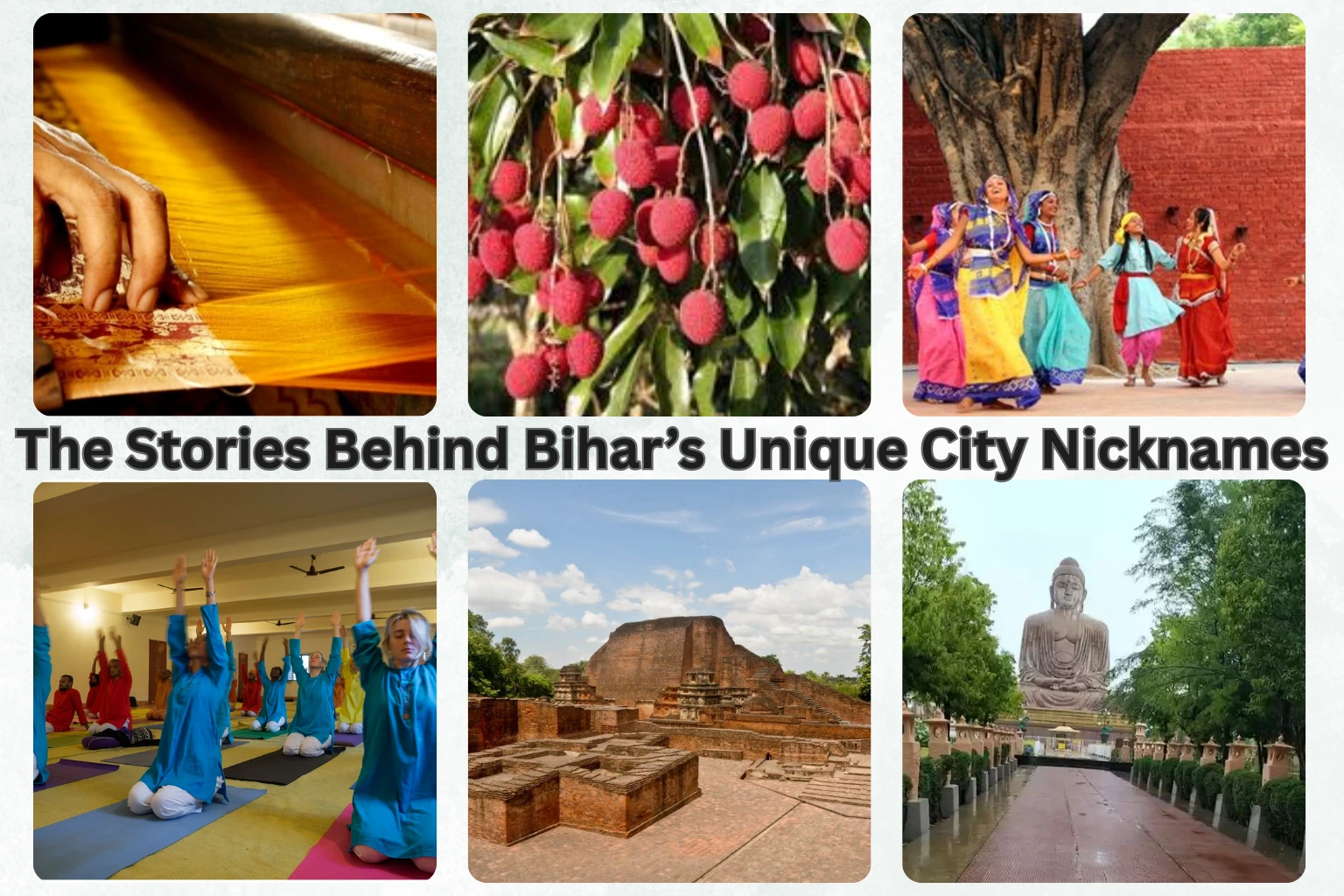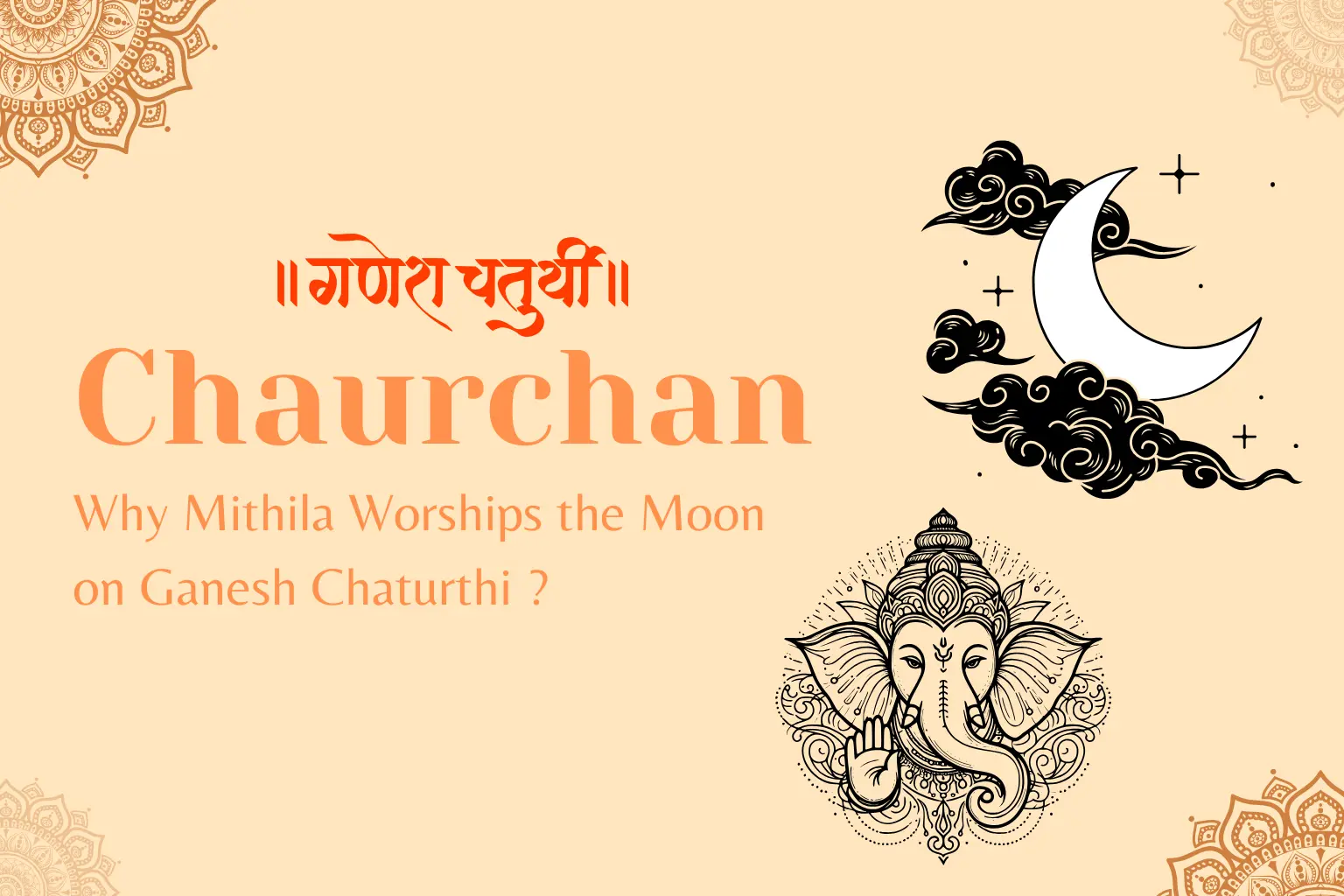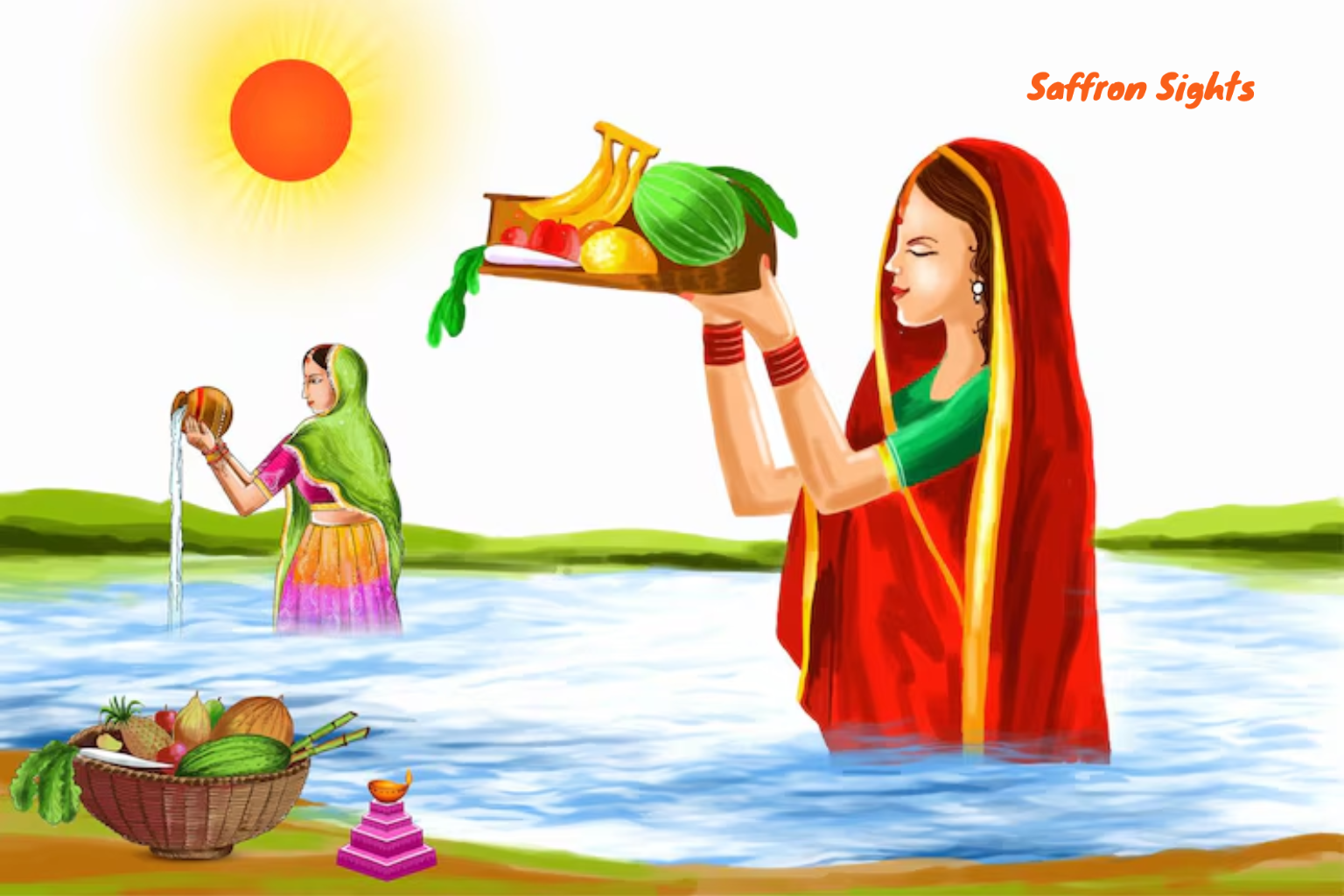Have you ever wondered why Indian cities have quirky nicknames? Bihar’s cities are steeped in history, culture, and hidden stories!
Bihar, a state rich in cultural diversity, has a plethora of cities, each with its own unique identity and historical significance. From the “Silk City” of Bhagalpur to the “Litchi Kingdom” of Muzaffarpur, every nickname tells a tale of tradition, craftsmanship, and heritage.
Let’s explore the “why,” “how,” and “story” behind each nickname, along with fascinating facts and prospects.
Bhagalpur: The Silk City of Bihar
Why this name?
Bhagalpur, nestled on the southern banks of the Ganges, is renowned as the “Silk City” of India. This moniker is deeply rooted in its rich history of silk production, particularly the famous Tussar silk, which dates back over 2,000 years. The city’s silk industry flourished under Mughal-era patronage, establishing Bhagalpur as a hub for exquisite silk craftsmanship.
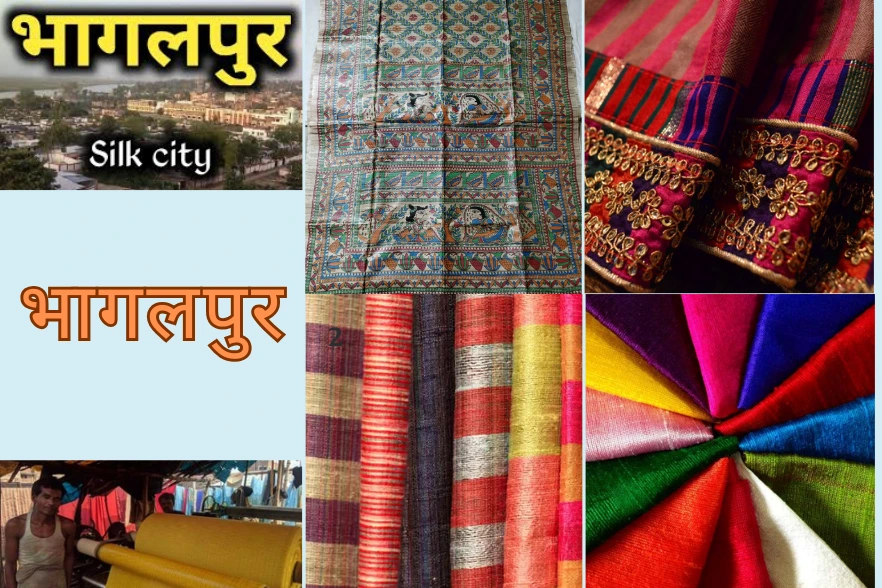
What makes it special?
Bhagalpur’s silk industry thrives due to its ideal climate for silkworms and the intricate craftsmanship involved in producing Bhagalpuri sarees. The meticulous process of creating Bhagalpur silk involves traditional handloom weaving combined with sustainable manufacturing practices, resulting in luxurious fabrics known worldwide.
What’s happening now?
Today, Bhagalpur faces challenges from cheap synthetic fabrics, but the city is innovating with sustainable silk production methods. Initiatives are underway to preserve traditional techniques while embracing modern technologies to keep Bhagalpur’s silk industry vibrant.
Did you know?
Bhagalpur’s silk was once highly prized and exported to ancient Rome, showcasing its timeless appeal.
Tip: The best time to visit Bhagalpur’s silk weaving clusters is during festival seasons when the city’s cultural richness is on full display.
Muzaffarpur: The Litchi Kingdom
Why this name?
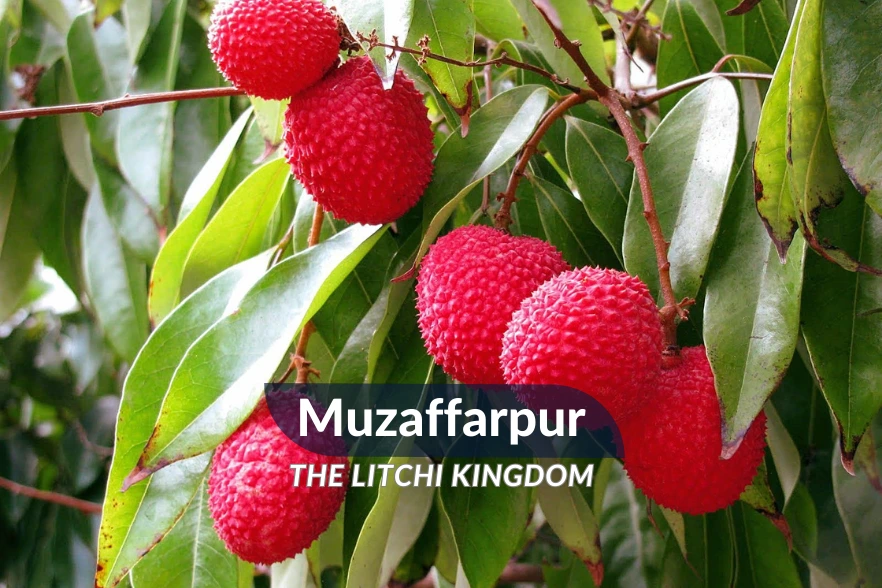
Muzaffarpur, located in northwestern Bihar, is famously known as the “Litchi Kingdom.” This nickname originates from the British era when litchi cultivation was first introduced. The “Shahi” litchi variety, known for its unique taste and aroma, has made Muzaffarpur synonymous with this delicious fruit.
What makes it special?
The unique soil composition of the Gangetic plains provides the perfect conditions for growing litchis. Muzaffarpur’s litchis are renowned for their juicy pulp and smaller seeds, making them a favorite among connoisseurs.
What’s happening now?
Muzaffarpur’s litchis have earned a Geographical Indication (GI) tag, recognizing their unique qualities. The city aims to expand its global export ambitions and introduce the world to the delightful taste of Shahi litchis.
Did you know?
Muzaffarpur’s litchi honey is a rare delicacy, sought after for its unique flavor and health benefits.
Tip: When in Muzaffarpur, be sure to try litchi-based desserts at local markets for a truly authentic experience.
Darbhanga: The Cultural Capital
Why this name?

Darbhanga is celebrated as the “Cultural Capital” of Bihar, a title earned through the legacy of the Darbhanga Raj. This royal family’s patronage of the arts has left an indelible mark on the city’s cultural landscape, fostering a rich heritage of music, art, and dance.
What makes it special?
Darbhanga is renowned for its Maithili music, Madhubani art, and classical dance traditions. The city’s cultural institutions continue to nurture these art forms, ensuring their preservation for future generations.
What’s happening now?
Darbhanga is focusing on digitally archiving its cultural heritage and organizing festivals to revive and showcase its rich traditions to a global audience.
Also Read: Discover the Culture of Darbhanga
Did you know?
The Darbhanga Fort’s library houses ancient Sanskrit manuscripts, offering a glimpse into the region’s scholarly past.
Tip: Attend the Malmaas Mela in Darbhanga for an immersive experience of folk performances and local art.
Munger: The Yoga Nagri
Why this name?

Munger earned the nickname “Yoga Nagri” thanks to the vision of Sri Swami Satyananda Saraswati, who established the Bihar School of Yoga in 1963. This institution has since become a global influence in the world of yoga and wellness.
What makes it special?
The Bihar School of Yoga has attracted students from around the world, spreading the practice of yoga and its benefits. Munger’s tranquil environment and rich spiritual heritage make it an ideal destination for yoga enthusiasts.
What’s happening now?
Munger is experiencing a boom in wellness tourism, with an increasing number of yoga retreats and health resorts catering to visitors seeking spiritual and physical rejuvenation.
Did you know?
Munger is also known for its traditional handmade guns, a craft that has been passed down through generations.
Tip: Attend the International Yoga Festival, held annually in Munger, to deepen your yoga practice and connect with fellow enthusiasts.
Nalanda: The Land of Learning
Why this name?

Nalanda is celebrated as the “Land of Learning,” a title that dates back to the 5th century CE, when the ancient Nalanda University was established. This institution was a beacon of knowledge, attracting scholars from around the world.
What makes it special?
Nalanda University was a UNESCO World Heritage Site, renowned for its vast library and the exchange of ideas among global scholars. The modern Nalanda University aims to revive this legacy of academic excellence.
What’s happening now?
Efforts are underway to restore Nalanda University to its former glory, with a focus on attracting international students and faculty.
Did you know?
Legend has it that the ancient library of Nalanda was so vast that it burned for months during an invasion, highlighting the immense knowledge it housed.
Tip: Visit the Xuanzang Memorial Hall in Nalanda to explore the historical ties between Chinese and Buddhist cultures.
Gaya: The Land of Enlightenment
Why this name?

Gaya is revered as the “Land of Enlightenment,” a nickname derived from its significance as the place where the Buddha attained enlightenment under the Bodhi Tree.
What makes it special?
Gaya is a pilgrimage site for both Hindus and Buddhists. The city’s spiritual significance draws visitors from around the world who seek inner peace and enlightenment.
What’s happening now?
Gaya is upgrading its infrastructure to accommodate the growing number of spiritual tourists, ensuring a comfortable and meaningful visit for all pilgrims.
Did you know?
The Bodhi Tree in Gaya is believed to be a direct descendant of the original tree under which the Buddha meditated.
Tip: Attend the Pitru Paksha festival in Gaya to participate in ancient rituals and experience the city’s spiritual atmosphere.
Madhepura: The Electric Loco Capital
Why this name?

Madhepura earned the nickname “Electric Loco Capital” with the establishment of Indian Railways’ mega factory in 2018. This initiative is part of the Make in India program, which aims to boost domestic manufacturing.
What makes it special?
Madhepura’s strategic location and advanced infrastructure make it an ideal hub for producing electric locomotives, which will contribute to India’s green energy goals.
What’s happening now?
The factory in Madhepura will produce over 500 locomotives annually, driving innovation in green transportation and creating job opportunities.
Did you know?
Madhepura’s factory is one of the largest of its kind in the world, showcasing India’s commitment to sustainable development.
Tip: Visit Madhepura during open-house events to witness the engineering marvels and learn about the future of green transportation.
Kishanganj: The Pineapple Farm of Bihar
Why this name?

Kishanganj is known as the “Pineapple Farm of Bihar,” a nickname that originates from British-era experiments in pineapple farming. The region’s ideal climate and organic practices have made it a hub for pineapple cultivation.
What makes it special?
Kishanganj’s pineapples are renowned for their sweet taste and juicy pulp, thanks to the region’s ideal rainfall and organic farming methods.
What’s happening now?
Kishanganj is expanding its pineapple industry by developing pineapple wine and juice production, aiming to reach global markets.
Did you know?
Kishanganj’s climate is similar to Thailand’s pineapple regions, making it ideal for cultivating this tropical fruit.
Tip: Try pineapple pickles from local vendors in Kishanganj for a unique culinary experience.
Interesting Facts Section
Did You Know?
- Bihar produces 70% of India’s Tussar silk, highlighting Bhagalpur’s significance in the silk industry.
- Shahi litchi from Muzaffarpur has earned a Geographical Indication (GI) tag, recognizing its unique qualities and taste.
- Darbhanga’s classical music has influenced Bollywood, showcasing the region’s cultural impact on mainstream media.
Fun Comparisons:
- “Nalanda was the Oxford of the ancient world!” This comparison highlights Nalanda’s historical significance as a center of learning and academic excellence.
What’s Next for Bihar’s Cities?
Bihar is witnessing a surge in government initiatives aimed at promoting tourism and preserving cultural heritage. Schemes such as silk cluster development, sustainable tourism trends, and youth-driven cultural startups are paving the way for a brighter future. These efforts aim to create a balance between modernization and the preservation of traditional crafts and practices.
Traveler Tips: Your Fun Guide to Exploring Bihar!
Best Time to Visit Each City
Want to enjoy the best weather and events? Here’s when to go:
- Bhagalpur & Muzaffarpur: October to March – Nice weather and lots to see!
- Gaya: September – Visit during Pitru Paksha for special rituals.
- Darbhanga: Winter – Perfect for colorful festivals and cool weather.
- Munger: November – Join the Yoga Festival and feel the calm.
Places to Explore
Don’t miss these hidden treasures:
- Vikramshila Ruins in Bhagalpur: Walk through old buildings and imagine ancient times!
Local Dishes You Must Try
Bihar has tasty treats! Here are some local favorites:
- Litchi Kheer – A sweet dish from Muzaffarpur made with juicy litchis.
- Makhan-Malai – A soft and creamy dessert in Darbhanga, loved in winter.
- Silk-Wrapped Sweets – Special sweets from Bhagalpur are found in local markets!
Final Thoughts: Bihar is Waiting for You!
Bihar’s cities, with their unique nicknames, offer a glimpse into the state’s rich cultural heritage and historical significance. From the silk weavers of Bhagalpur to the litchi orchards of Muzaffarpur, each city tells a story of tradition, innovation, and resilience. As Bihar embraces modernization while preserving its ancient legacy, it invites travelers to explore its vibrant culture and hidden stories. So, which city’s story intrigued you the most? Plan your Bihar journey today!
Frequently Asked Questions (FAQs)
Why do cities in Bihar have nicknames like “Silk City” or “Litchi Kingdom”?
These nicknames reflect the cities’ unique identity, cultural heritage, and historical or economic specialties — like Bhagalpur’s silk industry or Muzaffarpur’s famous litchis.
What is the best time to visit Bihar for cultural experiences?
October to March is ideal for most cities due to pleasant weather and festivals. Specific events, like Pitru Paksha in Gaya or the Yoga Festival in Munger, are held at unique times.
Can I visit the silk weaving clusters in Bhagalpur?
Yes! You can visit traditional handloom centers in Bhagalpur, especially during festivals for the full cultural experience. Local artisans often welcome tourists.
Are litchis available year-round in Muzaffarpur?
No, the best time to enjoy fresh litchis is between May and June. However, you can try litchi-based sweets and honey any time of the year.
What is special about the Darbhanga Fort and its library?
Darbhanga Fort is a symbol of royal heritage. Its library houses ancient Sanskrit manuscripts, offering a glimpse into scholarly traditions of the past.
How can I attend the Yoga Festival in Munger?
The International Yoga Festival usually happens in November. You can register in advance through the Bihar School of Yoga’s official website or local tourism boards.
Is Nalanda University open to tourists?
Yes. You can visit the ancient ruins, the modern Nalanda University campus, and the Xuanzang Memorial Hall for a rich historical experience.
What are some offbeat souvenirs to buy in Bihar?
Look for Bhagalpuri silk sarees, Madhubani paintings from Darbhanga, litchi honey from Muzaffarpur, and pineapple pickles from Kishanganj.
Are these cities safe and tourist-friendly?
Yes, Bihar is becoming increasingly tourist-friendly with improving infrastructure. However, like any destination, basic travel precautions are recommended.
How can I explore multiple cities in one trip?
You can plan a theme-based itinerary—like a cultural trail (Darbhanga, Gaya, Nalanda) or a flavors of Bihar tour (Muzaffarpur, Kishanganj, Bhagalpur)—using trains or hired cabs.

